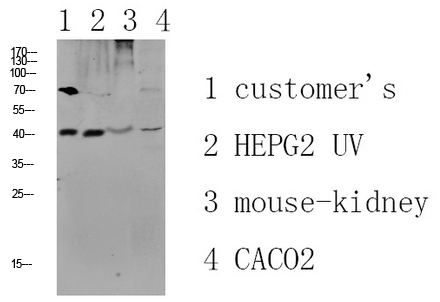CCR5 Polyclonal Antibody
- Catalog No.:YT6108
- Applications:WB;ELISA
- Reactivity:Human;Mouse;Rat
- Target:
- CKR-5
- Fields:
- >>Viral life cycle - HIV-1;>>Cytokine-cytokine receptor interaction;>>Viral protein interaction with cytokine and cytokine receptor;>>Chemokine signaling pathway;>>Endocytosis;>>Toxoplasmosis;>>Human cytomegalovirus infection;>>Kaposi sarcoma-associated herpesvirus infection;>>Human immunodeficiency virus 1 infection;>>Viral carcinogenesis
- Gene Name:
- CCR5 CMKBR5
- Protein Name:
- C-C chemokine receptor type 5 (C-C CKR-5) (CC-CKR-5) (CCR-5) (CCR5) (CHEMR13) (HIV-1 fusion coreceptor) (CD antigen CD195)
- Human Gene Id:
- 1234
- Human Swiss Prot No:
- P51681
- Mouse Gene Id:
- 12774
- Mouse Swiss Prot No:
- P51682
- Rat Gene Id:
- 117029
- Rat Swiss Prot No:
- O08556
- Immunogen:
- Synthesized peptide derived from human CCR5 Polyclonal
- Specificity:
- This antibody detects endogenous levels of CCR5.
- Formulation:
- Liquid in PBS containing 50% glycerol, 0.5% BSA and 0.02% sodium azide.
- Source:
- Polyclonal, Rabbit,IgG
- Dilution:
- WB 1:500-2000, ELISA 1:10000-20000
- Purification:
- The antibody was affinity-purified from rabbit antiserum by affinity-chromatography using epitope-specific immunogen.
- Concentration:
- 1 mg/ml
- Storage Stability:
- -15°C to -25°C/1 year(Do not lower than -25°C)
- Other Name:
- C-C chemokine receptor type 5 (C-C CKR-5) (CC-CKR-5) (CCR-5) (CCR5) (CHEMR13) (HIV-1 fusion coreceptor) (CD antigen CD195)
- Observed Band(KD):
- 40kD
- Background:
- This gene encodes a member of the beta chemokine receptor family, which is predicted to be a seven transmembrane protein similar to G protein-coupled receptors. This protein is expressed by T cells and macrophages, and is known to be an important co-receptor for macrophage-tropic virus, including HIV, to enter host cells. Defective alleles of this gene have been associated with the HIV infection resistance. The ligands of this receptor include monocyte chemoattractant protein 2 (MCP-2), macrophage inflammatory protein 1 alpha (MIP-1 alpha), macrophage inflammatory protein 1 beta (MIP-1 beta) and regulated on activation normal T expressed and secreted protein (RANTES). Expression of this gene was also detected in a promyeloblastic cell line, suggesting that this protein may play a role in granulocyte lineage proliferation and differentiation. This gene is located at the chemok
- Function:
- disease:Genetic variation in CCR5 is associated with suseptibility to insulin-dependent diabetes mellitus type 22 (IDDM22) [MIM:612522]. IDDM is caused by the body's own immune system which destroys the insulin-producing beta cells in the pancreas. Classical features are polydipsia, polyphagia and polyuria, due to hyperglycemia-induced osmotic diuresis.,function:Receptor for a number of inflammatory CC-chemokines including MIP-1-alpha, MIP-1-beta and RANTES and subsequently transduces a signal by increasing the intracellular calcium ion level. May play a role in the control of granulocytic lineage proliferation or differentiation. Acts as a coreceptor (CD4 being the primary receptor) for HIV-1 R5 isolates.,online information:CC chemokine receptors entry,online information:CCR5 receptor entry,polymorphism:Ser-60 variant, a naturally occurring mutation in a conserved residue in the first i
- Subcellular Location:
- Cell membrane ; Multi-pass membrane protein .
- Expression:
- Highly expressed in spleen, thymus, in the myeloid cell line THP-1, in the promyeloblastic cell line KG-1a and on CD4+ and CD8+ T-cells. Medium levels in peripheral blood leukocytes and in small intestine. Low levels in ovary and lung.
CD276-dependent efferocytosis by tumor-associated macrophages promotes immune evasion in bladder cancer Nature Communications Cheng Maosheng WB Mouse 1:1000 TAMs-epithelial cell
- June 19-2018
- WESTERN IMMUNOBLOTTING PROTOCOL
- June 19-2018
- IMMUNOHISTOCHEMISTRY-PARAFFIN PROTOCOL
- June 19-2018
- IMMUNOFLUORESCENCE PROTOCOL
- September 08-2020
- FLOW-CYTOMEYRT-PROTOCOL
- May 20-2022
- Cell-Based ELISA│解您多样本WB检测之困扰
- July 13-2018
- CELL-BASED-ELISA-PROTOCOL-FOR-ACETYL-PROTEIN
- July 13-2018
- CELL-BASED-ELISA-PROTOCOL-FOR-PHOSPHO-PROTEIN
- July 13-2018
- Antibody-FAQs
- Products Images

- Western blot analysis of various lysate, antibody was diluted at 1000. Secondary antibody(catalog#:RS0002) was diluted at 1:20000



